Tall, vigorous, extremely xeric yarrow. Can spread by seed.
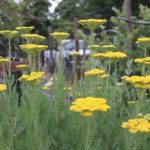
- Fernleaf Yarrow
- 3
- Sun
- 3' x 3'
- Central Asia


Tall, vigorous, extremely xeric yarrow. Can spread by seed.
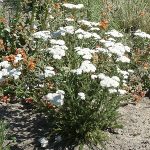
Western White Yarrow is a tough native wildflower with fragrant, lacy foliage and dense umbels of tiny white flowers in summer. Can spread aggressively by seed. Great attractor of beneficial insects. Tolerates variety of soil conditions. Pollinators: Butterflies and native bees. Firewise. More information here.
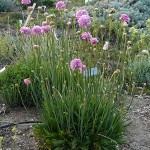
Taller and longer-blooming than its cousin, Thrift, this “False Thrift” is a colorful focal point in any garden. Evergreen foliage.
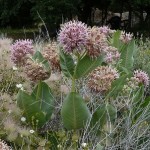
Showy Milkweed was once common, but modern agricultural techniques have largely eradicated this crucial pollinator plant. Milkweed provides larval food for the dwindling Monarch butterfly. It is tall and beautiful, but spreads through the garden by root–so choose the planting site with care!
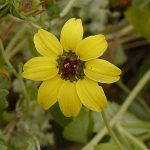
Chocolate Flower: Cheerful wispy yellow daisies keep coming all summer and actually smell like chocolate! Attracts butterflies, honey bees and beneficial insects.
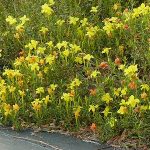
Hartweg’s Sundrops produces masses of cheerful, clear yellow blossoms throughout the heat of the summer and into fall. The yellow blooms age into burnt orange creating a two-tone effect. Easy-and reliable. Needs well-drained soil. Attracts: butterflies and bees.
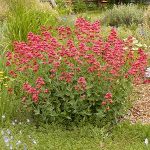
Jupiter’s Beard produces masses of crimson flowers fading to pink from late spring right through the summer. Periodic deadheading will enhance the bloom even more. Attracts Swallowtails and Monarchs. Can seed out somewhat aggressively. Firewise.
Easy, reliable.
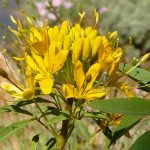
Yellow Bee Plant is a smaller cousin of the purple Rocky Mountain Bee plant, Both of these annuals are extremely valuable as food sources for native bees and butterflies as well as honeybees. Very long-blooming and freely reseeding in the garden. Available spring only.
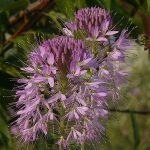
This outstanding native annual is a magnet for honey bees and native bees alike! Tall stalks end in multiple flowers that look as if they were designed by Dr. Seuss. Once it starts blooming in early to mid-summer, Rocky Mountain Bee Plant just keeps going until fall. More information here.
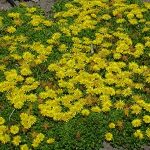
Hardy Iceplant is a fast-growing, mat-forming succulent, lovely garden accent. Bright yellow daisy-like flowers appear in late- spring. fall. Bright-green knobby leaves turn bright red during the winter. Avoid overwatering and excessive winter moisture. Firewise.
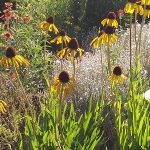
This is the only Coneflower with yellow rather than purple flowers. Its drooping yellow petals surround large, coppery-brown cones. Nectar plant for Monarch and other butterflies. Tolerates clay.
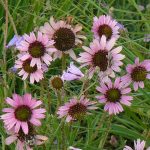
Shorter than other Echinaceas, Tennessee Coneflower cheerfully faces the rising sun and blooms like crazy–even despite heat and low water. Native to dry, rocky areas in Tennessee, it does well in the Intermountain West.
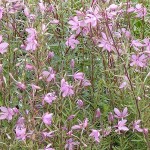
This is a miniature European version of our beautiful native Fireweed. We have been reluctant to offer Fireweed itself as it can be very invasive. Alpine Willowherb is much smaller and promises to be better behaved in the garden. Supports honeybees.
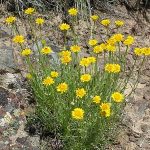
Desert Yellow Fleabane is a small native daisy with cheerful yellow flowers in summer. Grows in poor soil with little care.
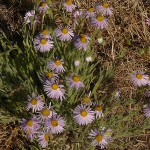
Cheerful little Shaggy Fleabane (Shaggy Daisy) is native to the Boise Foothills. It will survive without additional water, but will flower much more vigorously if given a bit of extra moisture.
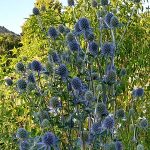
Steel blue thistle-like flowers on branched stems. Beautiful garden accent and cut flower. Thrives in poor soils.
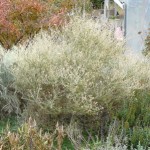
Apache Plume is a sturdy multi-branched Southwest native shrub. Its small white, rose-like flowers emerge over a long blooming season and are a favorite of honey bees and other bees. It is our favorite bee plants! The flowers are followed by charming, fluffy seed heads that give the plant its name. More info here.
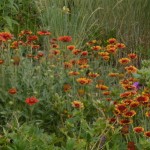
Cheerful red flowers with yellow tips. Adaptable and reliable, this native wildflower blooms for most or all of the summer. Give haircut to in mid-summer to promote more flowering. Will seed out without being invasive. Tolerates a wide variety of soil types. Pollinators: native bees, honey bees. Firewise. More information here.
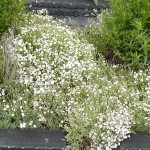
Creeping Baby’s Breath is a delicate spreading ground cover, creeping around other plantings and falling down walls. Covered with a burst of pink or white blooms, late spring. Easy and rewarding.
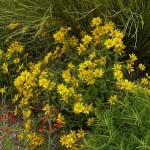
Cheery daisy-like flowers continue blooming all summer, especially beautiful in informal native or prairie gardens. Can seed out but is easily controlled. Tolerates some shade. More information here.
Tall spikes of tubular red flowers in summer attract hummingbirds. The basal leaves are long and narrow, but not sharp as in a true Yucca. Needs well-drained soil.
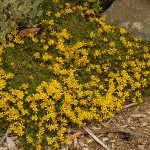
Jones’ False Golden Aster is a little known dwarf aster from southern Utah. Gradually spreads to form flat mats of gray-green leaves studded with bright yellow daisies all summer. A fantastic rock garden plant, it thrives in the heat requires little moisture and is not invasive.
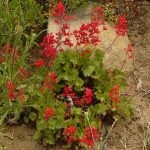
Alpine or Red Coralbells is another charming native Heuchera, this one with deep red to pink flowers on delicate wands. Great for full sun or dry shade. Sculpted evergreen foliage. Firewise.
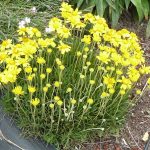
Sundancer Daisy is a cheerful, showy, long-blooming western wildflower and is a gem in the xeric garden. The attractive thread- leaf foliage is covered by bright-yellow, long-stemmed daisies in summer. Remarkably adapted to arid regions, from low desert to mountains. More information here.
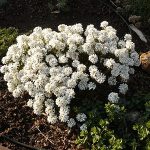
Very low growing, evergreen cushion with dark green leaves and large, white flowers in spring that can fade to lilac. Sun, very well-drained soil.
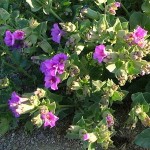
Colorado Four O’Clock dies back to its enormous root in winter. Then, late in the spring, shoots begin to emerge and once the plant starts growing—there’s just no stopping it! It can sprawl far and wide and looks lovely draped over a wall. Long-lived! Firewise. More info here.
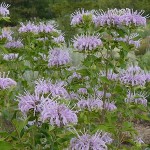
Beebalm or Wild Bergamot is a widespread native wildflower with clusters of tufted lavender flower, an important food source for native bees and butterflies. A long-lived, clump-forming perennial, it is attractive at the back of a border or in a meadow-like setting. Firewise. More information here.
Stunning pink Seedheads on SE native grass. Needs good drainage.
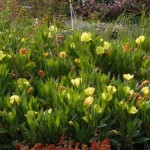
Missouri Evening Primrose grows into mounds of glossy leaves followed by clear yellow blossoms over much of the summer. Plants sprawl widely then die back to the ground in winter. Firewise.
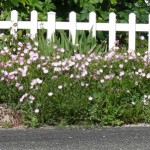
Showy Evening Primrose is a heat-loving beauty, thriving in sunny, dry areas. It can spread rapidly on shallow roots and can overrun smaller, less vigorous plants. Preferring unimproved, well-drained soils, this plant requires little extra water once established. Firewise. More information here.
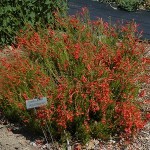
Pineleaf Penstemon has loads of red-orange tubular blooms over expanding clumps of attractive narrow leaves. Stems become woody with age. Evergreen foliage. Firewise. More information here.
Shrubby Cinquefoil is a small native shrub covered by small, yellow flowers all summer. Attractive foliage makes this a nice accent plant for sun or partial shade. Attracts bees and butterflies.
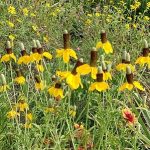
This cheerful wildflower has two forms, one yellow and one red. They both will bloom over a long period in hot, dry summers, attracting bees and butterflies. Great in meadows and other casual landscapes. Will seed around.
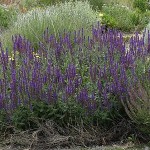
Blue Queen Salvia has spikes of violet-blue flowers in summer; tolerates intense heat and drought. Cut back after bloom for quick re-bloom. Magnet for honeybees and butterflies! Tolerates clay. Firewise.
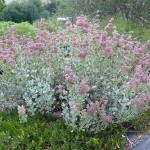
Giant Flowered Purple Sage is a tough, heat-tolerant summer-bloomer with spectacular clumps of deep purple flowers.Attractive gray-green foliage remains in winter. Needs well-drained soil. Attractive to bees, butterflies and hummingbirds. Tolerates clay. More information here.
Prairie Skullcap has neat mounds with tight, upright stems. Stunning deep lavender-blue flowers dotted with white, May through July.
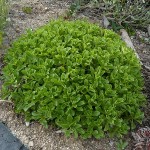
This compact mounding sedum is very useful in the landscape for small border areas and evergreen structure. Grown for foliage rather than flowers. Firewise.
Munro’s globemallow has dark maroon stems with dark-green, cut, lobed leaves and many heads of clear orange flowers.
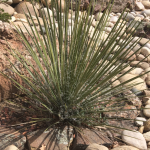
This handsome yucca has narrow, evergreen, spiky leaves and sends up a tall stalk of fragrant white flowers in late summer. Likes full sun and well-drained, sandy loam. Firewise and evergreen. More information here.

Clumps of thin, stiff, leathery white-margined leaves eventually produce flower stalks with creamy white bells. Evergreen. Firewise.